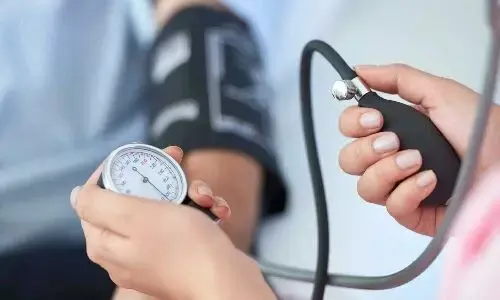- Home
- Medical news & Guidelines
- Anesthesiology
- Cardiology and CTVS
- Critical Care
- Dentistry
- Dermatology
- Diabetes and Endocrinology
- ENT
- Gastroenterology
- Medicine
- Nephrology
- Neurology
- Obstretics-Gynaecology
- Oncology
- Ophthalmology
- Orthopaedics
- Pediatrics-Neonatology
- Psychiatry
- Pulmonology
- Radiology
- Surgery
- Urology
- Laboratory Medicine
- Diet
- Nursing
- Paramedical
- Physiotherapy
- Health news
- Fact Check
- Bone Health Fact Check
- Brain Health Fact Check
- Cancer Related Fact Check
- Child Care Fact Check
- Dental and oral health fact check
- Diabetes and metabolic health fact check
- Diet and Nutrition Fact Check
- Eye and ENT Care Fact Check
- Fitness fact check
- Gut health fact check
- Heart health fact check
- Kidney health fact check
- Medical education fact check
- Men's health fact check
- Respiratory fact check
- Skin and hair care fact check
- Vaccine and Immunization fact check
- Women's health fact check
- AYUSH
- State News
- Andaman and Nicobar Islands
- Andhra Pradesh
- Arunachal Pradesh
- Assam
- Bihar
- Chandigarh
- Chattisgarh
- Dadra and Nagar Haveli
- Daman and Diu
- Delhi
- Goa
- Gujarat
- Haryana
- Himachal Pradesh
- Jammu & Kashmir
- Jharkhand
- Karnataka
- Kerala
- Ladakh
- Lakshadweep
- Madhya Pradesh
- Maharashtra
- Manipur
- Meghalaya
- Mizoram
- Nagaland
- Odisha
- Puducherry
- Punjab
- Rajasthan
- Sikkim
- Tamil Nadu
- Telangana
- Tripura
- Uttar Pradesh
- Uttrakhand
- West Bengal
- Medical Education
- Industry
Consistent maintenance of systolic BP below 130 mm Hg effective strategy to reduce diabetes risk in elderly, finds research

A new study published in the journal of Diabetes, Obesity and Metabolism showed that the risk of getting new-onset diabetes is greatly increased in elderly people with hypertension and raised systolic blood pressure (SBP).
Heart failure, stroke, and ischemic heart disease are among the serious cardiovascular events that are more likely to occur in people with type 2 diabetes. The association between blood pressure and the chance of developing diabetes with a recent beginning is less obvious, despite the fact that hypertension has long been acknowledged as a separate risk factor for both fatal and nonfatal vascular events. Thus, this study by Shanshan Li and colleagues was to investigate the relationship between blood pressure control, hypertension, and new-onset diabetes (NOD) in older Chinese people.
A total of 1380 participants of 60 years of age or older who were not previously diagnosed with diabetes in 2008 were included in a cohort analysis from the Chinese Longitudinal Healthy Longevity Survey. The evaluations were conducted again every 2 to 3 years. Multivariable-adjusted Cox regression was used to examine the connection between hypertension, blood pressure variations, and NOD.
- By 2018, 1278 individuals did not have diabetes, whereas 102 had the disease. At 3 years, the cumulative diabetes prevalence was 3.1%; at 10 years, it was 7.4%.
- The prevalence of hypertension rose over the course of 10 years, from 20.9% at baseline to 41.0%, with greater rates observed in the ones who were later diagnosed with diabetes.
- Age, gender, systolic blood pressure, and baseline hypertension were found to be independent predictors of NOD using multivariate analysis. Obesity and/or overweight elevated the risk of NOD substantially when paired with hypertension.
- After assessing the blood pressure control of participants between 2008 and 2011, this study monitored the occurrence of diabetes from 2011 to 2018. The greatest risk group, the ones with an average SBP of 140 mmHg or greater, had an 8-fold increased chance of getting NOD when compared to the ones whose SBP was below 120 mmHg in 2008 and 2011.
- There was no discernible difference in the risk between those with SBPs of 120-129.9 mmHg and those with SBPs of 130-139.9 mmHg. High SBP (≥ 130 mmHg) on a regular basis raised the risk of NOD.
Overall, gender, age, baseline hypertension, and blood pressure control were significant predictors of NOD. And so, keeping SBP continuously below 130 mmHg might be a useful tactic to lower the prevalence of NOD in the senior population as a whole.
Source:
Li, S., Yang, B., Shang, S., & Jiang, W. (2024). Association of hypertension and long‐term blood pressure changes with new‐onset diabetes in the elderly: A 10‐year cohort study. In Diabetes, Obesity and Metabolism. Wiley. https://doi.org/10.1111/dom.15986
Neuroscience Masters graduate
Jacinthlyn Sylvia, a Neuroscience Master's graduate from Chennai has worked extensively in deciphering the neurobiology of cognition and motor control in aging. She also has spread-out exposure to Neurosurgery from her Bachelor’s. She is currently involved in active Neuro-Oncology research. She is an upcoming neuroscientist with a fiery passion for writing. Her news cover at Medical Dialogues feature recent discoveries and updates from the healthcare and biomedical research fields. She can be reached at editorial@medicaldialogues.in
Dr Kamal Kant Kohli-MBBS, DTCD- a chest specialist with more than 30 years of practice and a flair for writing clinical articles, Dr Kamal Kant Kohli joined Medical Dialogues as a Chief Editor of Medical News. Besides writing articles, as an editor, he proofreads and verifies all the medical content published on Medical Dialogues including those coming from journals, studies,medical conferences,guidelines etc. Email: drkohli@medicaldialogues.in. Contact no. 011-43720751


